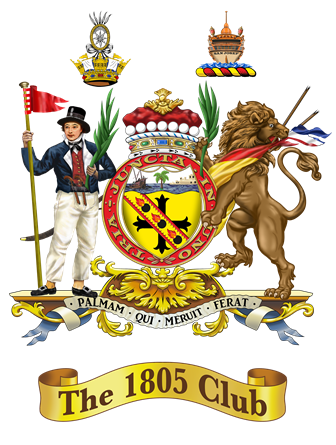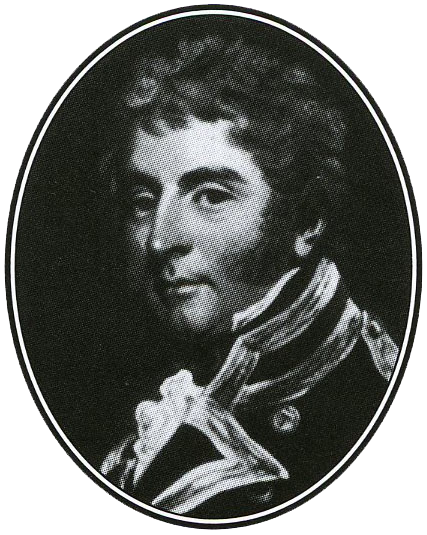The 1805 Club uses cookies to ensure you have the best possible online experience. By continuing to use this site you consent to the use of cookies in accordance with our cookie policy.
Early on the morning of 2 September 1805, Captain the Honourable Henry Blackwood, of hms Euryalus, arrived at Lymington and took a carriage to London with dispatches from Vice Admiral Collingwood, reporting that the combined French and Spanish fleets had taken refuge in Cadiz. He stopped briefly at Merton to advise Nelson of the news before proceeding on to the Admiralty. When Nelson was put in command of the British fleet and sailed for Cadiz in hms Victory, Blackwood was in attendance in hms Euryalus and went on board the Victory a number of times for discussions with Nelson. On arrival, Nelson put Blackwood in charge of the frigates and fast battleships watching the combined fleet, with instructions not to fail to inform him if it should sail, a task which Blackwood performed splendidly. During the battle, hms Euryalus acted as signal frigate to hms Victory, and after Nelson’s death, Collingwood shifted his flag to her. Because of his proficiency in French, Blackwood not only had the task of liaising with the Governor of Cadiz over the exchange of wounded sailors, but also the job of carrying the captured Admiral Villeneuve and his suite to England. So Blackwood performed a number of ancillary roles in the great victory of Trafalgar.
Born on 28 December 1769 in Northern Ireland, the seventh son and tenth child of Sir John Blackwood, Henry Blackwood joined the Royal Navy at the age of twelve, and served his time as a midshipman before passing his lieutenant’s examination in 1789. His first significant fleet action was in 1794 at the Battle of the Glorious First of June, in which he was the first lieutenant of hms Invincible, and after the battle was given command of the captured La Juste, and brought the prize into Portsmouth. He was promoted commander and given command of the fireship hms Megaera. He was made a post captain in June 1795. After time in hms Nonsuch, he was given command of hms Brilliant in which he distinguished himself in a skirmish off the Azores, with two larger French frigates. He then took command of hms Penelope in which his gallantry first came to Nelson’s attention. As one of the watching frigates off Malta, the frigate hms Penelope (36) spotted the shadowy form of the French ship Guillaume Tell (80) trying to slip away unobserved – Blackwood gave chase, and by superb seamanship managed to damage the much larger French ship and slow her down, until the British ships of the line came up to finish the job. Nelson wrote a very warm letter to Blackwood as a result of his action, beginning,
Is there a sympathy which ties men together in the bonds of friendship without having a personal knowledge of each other? If so (and I believe it was so to you) I was your friend and acquaintance before I saw you.
June 1803 saw Blackwood as the captain of the new frigate hms Euryalus, built at the famous Adams yard at Buckler’s Hard, in which he saw much service in the English Channel, watching the French preparations for invasion. Then in 1805 came the Battle of Trafalgar. Blackwood enjoyed Nelson’s confidences and friendship – he was even, with Captain Thomas Hardy, a witness to Nelson’s famous last codicil to his will, in which he left Emma Hamilton and their daughter as ‘a legacy to my King and Country’.
At Nelson’s funeral, Captain Blackwood attended as trainbearer to the chief mourner, Admiral of the Fleet Sir Peter Parker. He was then appointed to command of hms Ajax and sailed to join the Mediterranean fleet, but in the opening stages of the Dardanelles operation, disaster struck and the Ajax caught fire, with great loss of life. Blackwood was fully exonerated of blame, and after returning to England was given command of the new hms Warspite (74), and stayed with her, principally in the Mediterranean, for the next five years.
In 1814, he was appointed captain of the fleet to Prince William Henry, Duke of Clarence. In that role, he was responsible for the arrangements for the reception for the Tsar of Russia and the King of Prussia, when they visited Britain following the first defeat of Napoleon, including a fleet review at Spithead. Later that year, he was promoted rear admiral of the blue and was made a baronet, and in 1819 was created a KCB.
At the end of 1819, Sir Henry was appointed Commander-in-Chief East Indies, and sailed in hms Leander, to be based principally at Trincomalee, returning home in December 1822. In 1827, he was appointed Commander-in-Chief Nore, a post that he held until August 1830.
Unfortunately, his son Captain Henry Martin Blackwood contracted typhus, and Sir Henry took him to the ancestral home in Northern Ireland to nurse him. Young Henry survived but Sir Henry caught the disease from his son, and died on 13 December 1832, Vice Admiral of the White, leaving his wife and four children.
LB
Memorials
Type: Wall Plaque
Material: Marble
Location: Westminster Abbey, London, north transept, northernmost bay, east side at the top, on the back of the Pitt monument.
Click here to read more…
Type: Vault
Material: Granite
Location: St John the Evangelist Church, Killyleagh, Co Down
Click here to read more…
Type: Wall Memorial
Material: Marble, Slate
Location: Killyleagh Church
Click here to read more…
The Chairman's Dispatch
Regular updates from The 1805 Club’s Chairman. See the archive.
Topmen
To find out more and to become a Topman, please click here.
Membership Leaflet
See why others have joined our international membership. Join today! A Membership Leaflet is available for you to print out.
Admiral Lord Nelson
Visit Admiral Lord Nelson's own blog www.admiralnelson.org.
New Links





